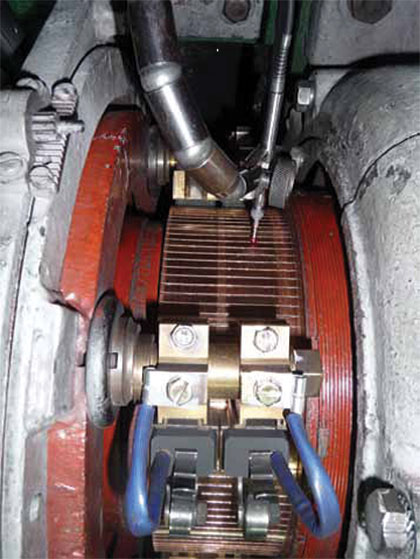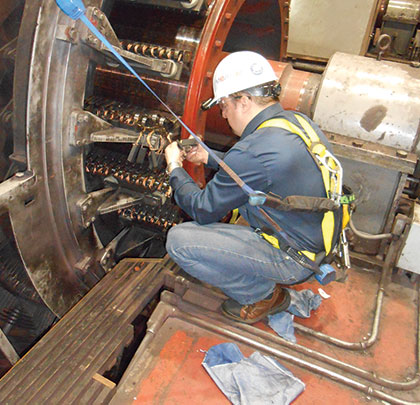Though DC motors may not be the latest state-of-the-art in technology, many railway and transit operators will trust in its reliability for many years to come. A global player like Mersen (founded in 1982, formerly known as Carbone Lorraine) is well aware that brushless three-phase AC drives are increasingly replacing the classic DC motor in many applications.
But this is a very slow process—and DC motors will be widely used for many years to come. Companies still and will rely on their robustness and high degree of reliability.
PROPER CARE OF CARBON BRUSHES
Every operator is, in this regard, aware of the importance of proper maintenance and care. The carbon brushes and—and to a lesser extent—the brush-holders often act as sensors that indicate emerging difficulties and problems at an early stage and provide warning when the motor is no longer operating “smoothly and efficiently”.

Specialists conducting “open heart surgery” on a DC motor
A SUBTLE PROBLEM
In many cases, a simple replacement of the carbon brushes or grades will not help. The real problem is less apparent. After more than one hundred years of experience with carbon brushes, one would tend to think that all possible eventualities would have come to light by now. But it is often the case that a new design of carbon brush is required to solve problems the user is experiencing with his motor application.
In this regard, the Mersen application experts have just recently come across a tricky operating situation at one of their clients’ premises. They redesigned the carbon brush and solved a commutation problem whose root cause laid in the geometric design of the commutator bars / carbon brush thickness relationship.
REGULAR INSPECTION IS KEY
This success has enabled Mersen’s experts to solve the problems of other railway and transit drives that were experiencing similar problems with their motor applications.
Not always is such a special solution required. Still, a regular inspection of the DC motor in terms of visual examinations and concentricity checks remain essential. Mersen has therefore decided many years ago to develop the required control devices and to offer these to our clients.
This means that formerly quite elaborate concentricity measurements are no longer considered as “witchcraft.” Results can be obtained within mere minutes:
- Is my commutator’s run-out still within the permissible range?
- How and where do concentricity problems reveal themselves? How are they developing?
SOFTWARE HELPING HARDWARE
PC-based software connectable to virtually any laptop or tablet using standardized interfaces, the special sensors deliver answers and provide charts using clear and easy-to-use software, which indicate even the smallest deterioration of commutators at an early point in time.
This helps with the definition of faults and errors as well as their rectification by repair specialists or the clients own maintenance personnel. This increases the useful service life time of the drive unit significantly.
Mersen can therefore not only deliver the appropriate “hardware” (carbon brushes, carbon brush grades and brush-holders) to its partners, but also the matching diagnostic equipment and “software” used to detect possible sources of errors and faults and to apply suitable solutions. ◆
Roy Douglas is technical manager—electrical applications at Mersen USA. An ex-motor design engineer at GEC Machines South Africa (now Alstom), Roy has thirty years’ experience in the application of carbon brushes in electric machines. Mersen, a global expert in electrical specialties and graphite-based materials, designs innovative solutions to help its clients optimize their manufacturing process in sectors such as energy, transportation, electronics, chemical, pharmaceutical, and process industries. For more information, visit www.mersen.com.
____________________________________________
MODERN PUMPING TODAY, May 2015
Did you enjoy this article?
Subscribe to the FREE Digital Edition of Modern Pumping Today Magazine!
![]()


